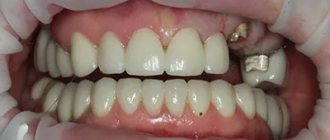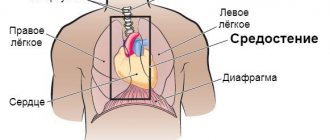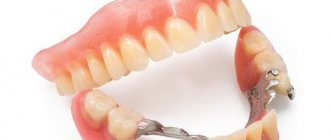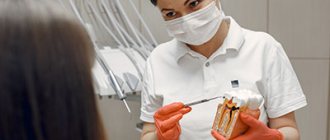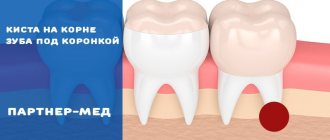Teeth are destroyed not only under the influence of acid-producing bacteria, but also due to traumatic external influences. In both cases, one or more of its roots remain in the gum as a memory of the destroyed tooth. One of the fundamental principles of modern dentistry is the use of tooth-preserving techniques.
Therefore, dentists literally fight for every affected tooth. But if the crown is completely destroyed, and treatment of the roots and restoration of the tooth with a composite or inlay is no longer possible, the doctor will definitely recommend removing the roots and resorting to implantation - the most effective prosthetic method to date.
Unfortunately, only some patients make an appointment with a dentist to find out how to restore the integrity of their dentition. The rest, not experiencing any discomfort for the time being, are in no hurry to get an appointment at the clinic.
When is tooth root removal required?
The decision to remove a tooth root can only be made by the attending physician, taking into account the patient’s indications in a particular case. If the affected tooth root can be treated, then the necessary procedures can be carried out and used as a support for the crown. However, there are a number of scenarios that require mandatory root removal.
- If, as a result of advanced periodontitis, the tooth has become mobile.
- When the root of a tooth is broken or cracked and hurts, and the gums and cheek are swollen.
- If the tooth is destroyed to the level of gum tissue and cannot be restored.
- When a wisdom tooth interferes with the development and alignment of other teeth or causes constant pain.
- If there is a cyst that cannot be removed without removing the root.
- If the wall of the tooth breaks off, and the resulting fragment extends under the gum.
- When part of the root remains after tooth extraction.
Separately, it is worth noting the removal of the root of baby teeth - usually dentists prefer to let the tooth fall out on its own, but sometimes intervention is necessary, for example, when more than half of the tooth is damaged by caries; when the tooth is very loose; if a tooth is broken and its remainder injures the gums; when the root is affected by caries and there is a risk of spreading to the adjacent tooth; with severe inflammation in the root area, which cannot be eliminated without resorting to removal.
When and how can you restore a tooth with Cerec?
A common problem is the development of caries on the frontal units. The result is their complete destruction. The patient sometimes comes too late. Or the previous intervention does not bring the desired result. When several units in the smile area are damaged, and some of them only have tooth root tissue left, you can combine the installation of crowns, veneers and restoration of the upper visible part using special inlays in the root system. Sometimes large-scale intervention is needed - the smile area is corrected, damaged teeth are recreated. You can do a step-by-step restoration of 10 or even 20 teeth above and below.
Using Cerec technology, if there is a healthy root, it is easy to restore almost every tooth within a few hours.
- It will be necessary to determine the condition of the root and undergo a course of treatment.
- Then, after treating the upper roots, it is possible to install a module with the alignment of the tooth crown and the insert into the cavity in the tooth root.
A smile should always be charming. When restored, the new units are ideal, better than natural ones. In addition, natural teeth darken under the influence of pigments or turn yellow with age. Therefore, next to the restored ones they look unaesthetic.
To avoid such consequences, units can be corrected with veneers or crowns (when they are 50% destroyed and there is no stable support). To create an impeccable beauty zone thanks to Cerec, you only need a few visits to the doctor.
Is it possible to leave it?
Some patients can walk for years with a tooth destroyed to the ground, not realizing that rotting roots are a breeding ground for infection and, at a minimum, provoke constant bad breath. Affected roots absorb bacteria and food particles like a sponge. Over time, plaque and stone form on the remnants of the root, causing the gum tissue to become inflamed.
Often patients ignore the problem, hoping that root removal without a tooth will not be necessary, since it will come out on its own. This is a big misconception - in rare cases, a fragment of a tooth can actually come out, but not its root. Delay will only lead to the root becoming overgrown, which is why the gum will have to be cut to remove the root of the destroyed tooth.
The body's constant fight against infection in the root area means that the human immune system directs part of its resources to solve the problem. Ultimately, this will provoke the development of infection and inflammation, and for patients this turns out to be a surprise every time. In some cases, if the rotten tooth root is not removed in time, infection in the upper jaw can spread to the maxillary sinuses, and in the lower jaw it can lead to a fracture or osteomyelitis.
Signs that a root remains after tooth extraction
If the root remains in the gum after a tooth extraction was performed poorly, then the problem is difficult to identify without diagnosis. But if a lot of time has passed since the extraction, and you feel twitching or pulsation in the area of the missing tooth, acute pain due to mechanical impact, observe redness or bleeding from the gums, or increased temperature, this may very likely indicate the presence of a tooth root remnant. If a root remains in the gum after tooth extraction, the consequences will not take long to arrive. Therefore, as soon as you have such a suspicion, contact a specialist as soon as possible.
CONCLUSIONS:
As you can see from the examples provided, I, orthopedic dentist Sergei Samsakov, an expert in the field of digital modeling and restoration of teeth using Cerec, manage to restore a beautiful smile even in almost the most hopeless cases. If you have similar problems, do not hesitate, contact us, and we will always find the optimal and, most importantly, beautiful solution to your situation.
And remember the simple truth: there are no hopeless situations!
Stages of removing the root of a decayed tooth
The operation of removing the root of a tooth is a procedure even more labor-intensive than removing a whole tooth. Preparation standardly includes a visual examination of the oral cavity, diagnosis using special equipment and sanitation. The test results allow you to draw up a treatment plan in accordance with medical indications, age, health status and other characteristics of the body, as well as select the optimal instruments and anesthetics for the procedure.
How is root removal done without a tooth?
- The doctor injects the patient with a local anesthetic, selected in such a way as to exclude allergies and other body reactions.
- After 10 minutes (when the anesthetic has taken effect), the circular ligament is separated from the neck of the tooth. If there is no inflammation of the gum tissue, then they are also moved away from the edge of the alveoli. If the root is deeply recessed into the hole or has become overgrown, then you will need to cut the gum and drill out part of the bone tissue to access the root.
- Next, the tooth root is removed using forceps or a dental elevator. If the tooth has a multi-root system, it will first be separated using a drill or ultrasound, and then removed in parts. This is called complex removal.
- After removing the tooth root, the hole is treated with a special solution. If the gum is cut, then after the operation sutures are placed and the operated area is treated with drugs that will help speed up healing.
Note!
Removing the root of the upper teeth is somewhat different from removing the roots of the lower jaw tooth. The roots of the lower jaw are most often removed using elevators: the instrument is placed between the gum bone tissue and the root and the handle is rotated. When removing the roots of the teeth of the upper jaw, bayonet-shaped forceps are often used - medium for canines, incisors and premolars and wide for molars. Using a tool, the circular ligament of the tooth is first peeled off, then single roots are twisted, and those connected to each other are dislocated.
What to do after deletion
After any surgical intervention, you should follow all the dentist’s recommendations, as well as:
- do not eat for 2 hours after the procedure;
- cool the soft tissues of the face in the projection of the removed root;
- stop smoking for two days;
- take prescribed pain medication;
- make antiseptic applications;
- watch to see if other teeth are crumbling.
Sometimes after complex extractions, dentists prescribe antibiotics to patients.
This appointment cannot be ignored - after a tooth is pulled out of the socket, a focus of infection forms in it, which can only be extinguished with the help of medications.
The following video schematically shows different methods for removing incisors, canines, molars and premolars of the lower and upper jaw.
Features of wisdom tooth root removal
When removing the root of wisdom teeth, the complexity of the procedure is added by the fact that figure eights often grow at an angle; accordingly, their roots are located perpendicular to the roots of neighboring teeth. Therefore, the procedure is carried out using x-rays, especially if the crown is destroyed. The procedure should be carried out by an experienced specialist to eliminate the possibility that a root remains after the removal of a wisdom tooth.
How to determine if a root is healthy
How to understand whether caries has affected the root of the tooth, whether the dentin of the tooth root is intact or whether there are defects? In order to have an objective picture of the process, it is necessary to perform an x-ray of the tooth root and a computed tomogram. A CT scan will determine the true condition of the root and show:
- The presence of inflammatory processes.
- It will determine whether there are neoplasms and what size they are (cyst or granuloma).
- The location of the roots in relation to the neighboring ones, the maxillary sinus.
This is the only way to see whether it will be possible to cure the tooth root using a tab.
Tooth root removal under anesthesia
As a rule, root removal is performed under local anesthesia, but if the patient has a complex tooth root extraction, or if he has intolerance to local anesthetics or dentophobia, the specialist performs the procedure for tooth root removal under general anesthesia. This allows all manipulations to be carried out with complete comfort for the patient - while he is sleeping. However, this method has a number of serious contraindications: its use can have a negative effect on the heart, kidneys and brain. In addition, patients often experience nausea, headache, and confusion as they emerge from anesthesia. Therefore, they try to resort to anesthesia only as a last resort, giving preference to sedation. This is a modern type of general anesthesia, which involves deep relaxation, during which the patient remains conscious and can contact the doctor, but with this type of tooth root removal, pain and stress are completely eliminated.
Indications and contraindications
The attending physician (therapist) or orthodontist directs the removal of a molar in the lower jaw. In any case, the patient is sent for a panoramic photo, where the location of the teeth is visible. This procedure facilitates the work of the surgeon who has to deal with a complex operation. Contraindications for removal are as follows:
- Pregnancy and breastfeeding. After such a complex removal, the mother will have to stop breastfeeding, because antibiotics and painkillers can get into the baby along with the milk.
- People of the older generation with a diseased heart, hypertension of the 2nd or 3rd degree should be attentive to their health and not rush into surgery, but it is better to refuse it altogether.
- Malignant formation in the tooth growth zone.
Tooth extraction is also done as a preventive measure in advance, so that later they do not hurt and do not interfere with others.
Tooth root amputation as a treatment
In some cases, complete tooth root removal can be replaced by a tooth-saving operation called amputation. This is the removal of part of the tooth root, allowing you to save a healthy fragment. During the procedure, the affected area is cut off and the cavity is filled with osteoplastic mass.
Tooth-preserving extraction operations also include hemisection, in which part of the root system is removed along with the adjacent crown area. These two methods allow you to preserve the physiological function of the tooth and use it to install a bridge. It is important to understand: no doctor can guarantee that such a tooth will last a long time, since partial loss of the root will lead to a violation of the stability of the tooth. Therefore, if you notice that for a long time after root removal the tooth hurts or causes you other discomfort, you should definitely contact your doctor.
What if the roots are not affected by caries?
In dental practice, decisions about the need for root removal have to be made quite often. So, if a “living” healthy tooth splits due to injury, its roots are usually slightly damaged and can be saved. But the roots of a pulpless and treated tooth are, as a rule, removed so that they can be replaced with a titanium implant and a crown made of metal ceramics or zirconium dioxide can be installed on it. As a rule, destroyed rear molars, the most problematic in the dentition, are also removed along with the roots.
Quite often, even if there is a therapeutic option to preserve the root, real professionals still refuse it. They know from experience in which cases the crown will not be attached securely enough to the restored native root, and therefore will not be fully functional. Therefore, it is best to entrust the decision on the advisability of preserving roots to a highly qualified specialist.
How much does tooth root removal cost?
As a rule, the price for tooth root removal is determined based on the complexity of the case, and can vary greatly depending on the segment of the clinic, the qualifications of the doctor and other factors. Standard removal starts at an average of 3,000 rubles, complex removal will cost at least 5,000 rubles. Your attending physician will help you make more accurate calculations based on the diagnostic results. In any case, the sooner you go to the clinic, the less likely it is that complications will develop, especially since modern dental offices have all the capabilities to carry out the procedure efficiently and minimize the unpleasant consequences of tooth root removal.
The most frequently asked questions from our patients
What happens if the tooth root is left in the gum?
If the root of the tooth is left as is, it becomes a source of infection, and after some time serious complications may develop, for example:
- inflammation of the tissues surrounding the tooth, including bone;
- penetration of infection into the wound surface;
- periodontal disease.
What is a root canal and can it be treated rather than removed?
The root (or dental) canal is an anatomical space inside the root of a tooth filled with pulp. Cleaning and treatment of dental canals is a mandatory stage of dental fillings and prosthetics. In our clinic, for this purpose, we use self-adapting files of the SAF system, which carefully clean the canals from dead and diseased tissue, pus, and accumulations of bacteria, without injuring healthy areas of the tooth. Thanks to their hollow structure, the doctor can simultaneously treat the root canal with disinfectants and anti-inflammatory drugs. Root canals are preserved only if the tissues surrounding the tooth are not affected by pathological processes, and in the future the root can be used for prosthetics.
If the tooth can still be restored, root canal treatment (roots) of the tooth is performed. It can be successfully completed in our Moscow clinic.
Time and prices for the procedure
This complex operation takes about an hour. The duration of the procedure depends on the complexity of the figure eight position and the degree of neglect.
The consultation is free of charge. The final cost can be found out after consulting a specialist.
| Name of service | Unit | Price |
| Primary appointment (examination, consultation) with a dental surgeon | units | 0 |
| Repeated appointment (examination, consultation) with a dental surgeon | units | 500 |
| Complex tooth extraction with root separation | units | 7000 |
| Removal of periodontitis tooth | units | 2000 |
| Removal of a permanent tooth | units | 4000 |
| Flap surgery in the oral cavity in the area of the 1st tooth | units | 2000 |
| Flap surgery in the oral cavity on periodontal tissues (convet flap displacement) | units | 6000 |
| Removing stitches | units | 200 |
| Suturing the oral mucosa | units | 500 |
| The operation of removing an impacted, dystopic or supernumerary tooth | units | 8000 |
| Stopping alveolar bleeding without suturing using hemostatic materials | units | 500 |
A detailed price list can be found on the website.
Restoration method – bridge prosthesis
Dental bridges got their name for their visual resemblance to a bridge - they are a structure of two crowns, between which artificial teeth are located.
Crowns are placed on your own ground teeth. The advantages of bridges are good aesthetics and reliable fixation. Dental bridges are permanent, making them very comfortable. This type of dental prosthetics requires several visits to the doctor. First, impressions are made, from which a temporary prosthesis is made in a denture laboratory or clinic - the patient will not experience discomfort when communicating due to the absence of a front tooth. At the same time, the dental clinic prepares the supporting teeth. They are ground to install a crown to a shape that is optimally suitable for this, and most often (but not always) they are depulped. After the grinding is completed, impressions are taken again, from which dentists make a permanent prosthesis, and after that it is installed on the supporting teeth and fixed with cement.
The main disadvantage of a bridge is the need for depulpation and grinding of healthy supporting teeth. In addition, its installation, which leads to an uneven load on the alveolar bone and its thinning in the area of the missing tooth..

